Intel SSD 335 vs. Intel SSD 330 Review: Inexpensive SSD Evolution

Not so long ago Intel started slowly replacing their inexpensive SSD 330 series products with the newer SSD 335 ones. According to the manufacturer, there should be no major differences in the characteristics, but we disagree.
We’ve posted a number of reviews of solid state drives based on the second-generation SandForce controller. The rest of available controllers can only feel jealous of its popularity which is not even diminished by certain problems such as its somewhat blemished reputation, not very high performance, and lack of variation in SandForce-based products. There is just no other controller which, like the SandForce, would permit to manufacture SSDs without any preparatory engineering work. LSI, the developer of the SF-2281 chip, provides it bundled with everything necessary such as PCB design and firmware. The SSD manufacturer only has to actually assemble everything together on its production facilities.
That said, there are still a few original solutions that stand out among the crowd of identical SandForce-based SSDs. They are offered by Intel which designs its SSDs and develops firmware independently. As a result, Intel’s SandForce-based products are really different in their consumer properties. They are faster and have no stability issues. Intel itself seems to be quite satisfied with the SandForce platform as is indicated by its plans on releasing new modifications of SSDs with the same SF-2281 controller inside.
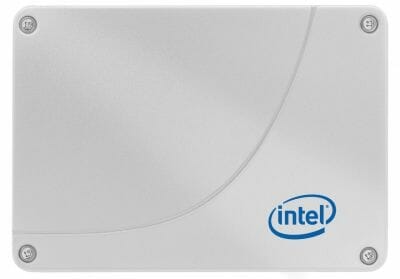
We were pleased with Intel’s first and flagship SSD we tested about a year ago. When benchmarked today, the Intel SSD 520 can still deliver good performance. Average in terms of speed, this series features immaculate stability and very high reliability thanks to premium flash memory with a service life of 5000 reprogram cycles. It comes with a 5-year warranty, by the way. That’s the longest warranty among all SandForce-based SSDs. So, the Intel SSD 520 is an interesting product, yet it couldn’t really be a market hit due to its high price. That’s why it was followed by more affordable solutions.
Some time ago we tested Intel SSD 330, which is similar to the Intel SSD 520 in design but has less reliable flash memory with a service life of 3000 program/erase cycles and is slowed down somewhat on the firmware level. The warranty period is shortened to 3 years. Otherwise, the Intel SSD 330 is quite a typical SSD from Intel. It is somewhat faster than other SandForce-based products, free from critical bugs, and perfectly compatible with the popular Intel SSD Toolbox utility.
Recently, Intel has come up with yet another affordable SSD which is even slightly cheaper than the SSD 330. The Intel SSD 335 model has provoked some excitement, especially as it doesn’t differ from the SSD 330 in its official specs. In this review we will try to find out why it is cheaper and in what features it actually differs from its cousin.
Intel SSD 330 240GB
First, we’d like to tell you a few words about the older affordable SSD from Intel. Our having got its 240GB version is a good reason for that. The series originally included models with up to 180 GB capacity, so the 240GB version was released later, following the consumer demand which had shifted towards larger storage capacities.
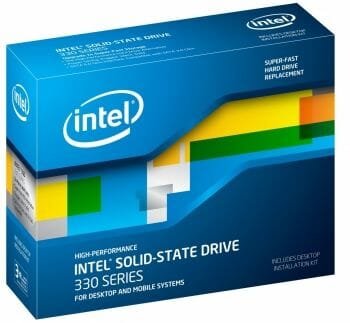
The Intel SSD 330 is different from the premium-class Intel SSD 520 whose case with a height of 7 mm allows it to be used in ultraportable computers as well. The Intel SSD 330 is 9 mm in height and thus less versatile. The manufacturing quality is immaculate, though. The robust metallic halves of the case are neatly fitted to each other.
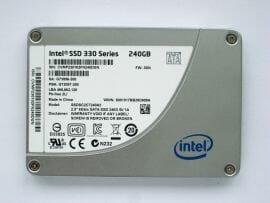
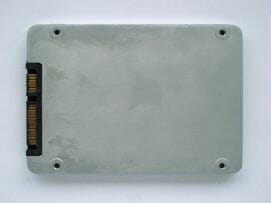
Opening the case, we can make sure that the Intel SSD 330 is architecturally identical to the SSD 520. Besides the SF-2281 controller and similar flash memory (synchronous 25nm flash with ONFI interface), the PCB design is the same. In fact, the PCB we’ve extracted out of our SSD 330 was labeled as Cherryville which is the codename of the 520 model.
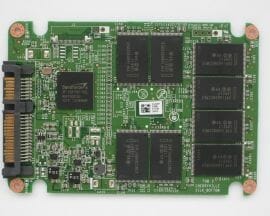
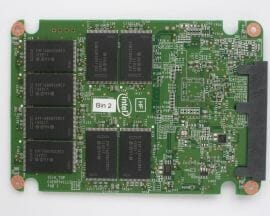
Like its senior cousin, the Intel SSD 330 contains 16 flash memory chips, each of which incorporates two 8GB NAND dies, so the controller can enable 8-channel access mode with 4-way interleave on each channel. This max-performance configuration is only implemented in the 240GB model, though. Take note that one sixteenth of the total capacity (i.e. the capacity of one flash memory chip) is not accessible for the user. It is allotted to the RAISE technology that improves data reliability.
Manufactured on 25nm tech process at Intel’s own facilities, the 29F16B08CCME2 chips are no different from those we saw in the Intel SSD 520, yet it doesn’t mean the two SSDs differ in firmware only. The flash memory of the affordable SSD 330 is rated for 3000 rather than 5000 reprogram cycles, which explains its lower price. This reliability parameter is not reflected in the chip marking, creating an impression that the SSD 330 contains the same hardware as the SSD 520.
Besides the warranty period and reliability, the SSD 330 is specified to have lower speeds:
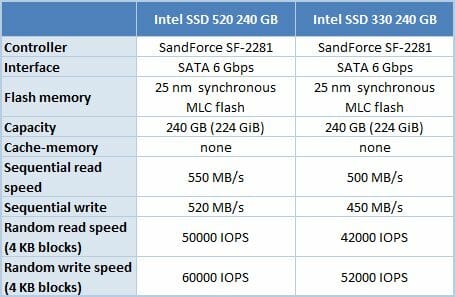
Considering the identical design, this can only be explained by firmware differences. Intel develops firmware independently of SandForce and separately for the two series. The lower performance of the SSD 330 seems to be a deliberate solution that reflects the market positioning of that model. On the other hand, specifications of any SandForce-based SSD are a marketing tool in the first place, so we will only be able to see the relative performance of Intel’s SSDs after we benchmark them ourselves.
We can only add that the 240GB Intel SSD 330 is an outdated product already. Its shipments will be over in the next couple of months and it will be replaced by the Intel SSD 335 240GB. Let’s see if that’s a worthy replacement.
Intel SSD 335 240GB
The 330 series is being phased out starting from the 240GB model. The new SSD 335 series is currently only available in 240 GB capacity, but 80 and 180GB versions are about to arrive, too. Other capacities are likely to appear as well because the point of the new series is in replacing the older 330 series models with ones that are cheaper to make.
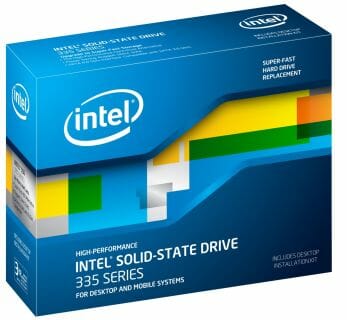
It is easy to explain why they are cheaper. Intel makes no secret of that, announcing in the specs that the SSD 335 series features new 20nm MLC flash memory. We’ve expected SSDs with such memory for quite a long time as IMFT began to mass-produce it in the middle of 2012. The progressive technology helped reduce the size of a typical 64-gigabit MLC NAND die from 167 to 118 sq. mm, thus lowering the manufacturing cost of one chip. That’s why the SSD 335 series is cheaper while delivering the same performance as the 330 series.
Indeed, we can’t expect any performance benefits because the new memory has the same design as the old 25nm variety. One 20nm NAND flash die is 64 gigabits in capacity and the memory pages have the standard size of 8 KB, too. The synchronous interface uses the ONFI 2.3 protocol which isn’t different from the previous versions in terms of bandwidth. ONFI 2.3 supports ECC controllers integrated into flash memory chips but Intel’s 20nm flash memory doesn’t offer such functionality right now, so the interface may be viewed as the same as before.
The reliability parameter hasn’t changed, either. Intel’s 20nm MLC NAND flash is rated for 3000 reprogram cycles, so the SSD 335 should be as long-lasting as the SSD 330. The new type of flash memory has lower power requirements, making the whole SSD much more economical. The 240GB Intel SSD 330 used to consume about 0.85 watts but the Intel SSD 335 only needs 0.35 watts.
Now let’s take a look at the actual drive. It resembles the above-discussed SSD 330 visually. The case is identical except that the sticker with product information has moved from the face to the reverse side.
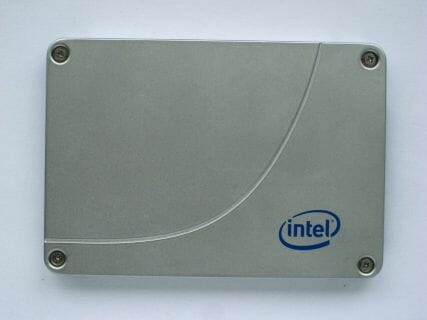
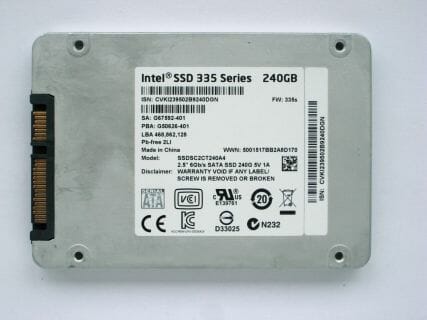
This SSD housing is going to be replaced for the SSD 335 series with another one that is partially made of plastic to differentiate the 20nm products from others.


Inside the case we can see the same unified hardware as in any other consumer-class SSD from Intel. The PCB is no different from the PCBs of the SSD 330 and SSD 520 series. It carries an SF-2281 controller and 16 chips of synchronous MLC NAND flash memory, each 16 GB in capacity. The chips are labeled 29F16B08CCMF2, the second letter F denoting the 20nm tech process the two flash memory dies hidden in each chip are made on.
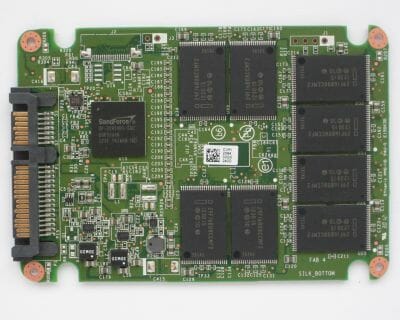
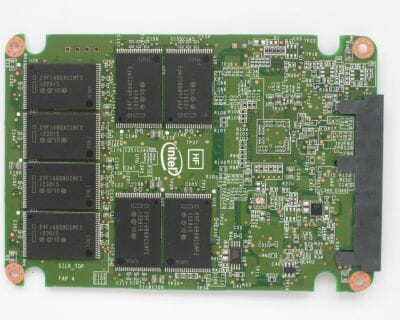
The SSD 335 differs from the SSD 330 in terms of firmware. The new series even has a firmware update that corrects SMART monitoring data. Basic firmware algorithms are the same for both series, though. The Intel SSD 335 is compatible with the SSD Toolbox utility which helps you manage the SSD and run some service features including TRIM and Secure Erase.
In other words, the Intel SSD 335 is an improvement on the SSD 330 that doesn’t differ much from the original. However, it will certainly be appreciated by end-users due to its price. While the Intel SSD 520 comes at $1.02 per a gigabyte of storage, the Intel SSD 330 costs about $0.83 per gigabyte and the SSD 335, only $0.73 per gigabyte.
Testbed Configuration
For our today’s SSD test session we put together a unified system on an Intel H67 based mainboard. This chipset provides support for two SATA 6 Gbit/s ports, which we use to connect the tested SSDs.
Two Intel SSDs from the same price range is already a very interesting topic in itself. However, since we previously didn’t have a chance to compare Intel SSD 330 and Intel SSD 335 against the products from the competition, we also decided to include all major SSD products available in the market these days for a more extensive comparison. The diagrams will include performance numbers for other products based on SandForce controller (Intel SSD 520 and Corsair Force GS) as well as for a variety of products with different hardware platform. Among them are: Corsair SSDs on LAMD LM87800 controller (Neutron GTX and Neutron), OCZ Vertex 4 on Indilinx Everest 2 controller, the newest OCZ Vector SSD on Indilinx Barefoot 3 controller, Crucial m4 on Marvell 9174, and Plextor SSDs on Marvell 9174 controller (M5S) and Marvell 9187 controller (M5 Pro). All above mentioned drives used synchronous flash memory. In particular, Crucial m4, Corsair Neutron, Intel SSD 520, OCZ Vertex 4, OCZ Vector and Plextor M5S use 25 nm IMFT memory with ONFI-interface. And Corsair Force GS, Corsair Neutron GTX and Plextor M5 Pro use Toggle Mode MLC NAND manufactured using 2x nm or 19 nm technology.
Overall our testbed was configured as follows:
- Intel Core i5-2400 (Sandy Bridge, 4 cores, 3.1 GHz, EIST and Turbo Boost turned off);
- Foxconn H67S mainboard (BIOS A41F1P03);
- 2 x 2 GB DDR3-1333 SDRAM DIMM 9-9-9-24-1T;
- Crucial m4 256 GB system disk (CT256M4SSD2);
- Tested SSDs:
- Corsair Force GS Series 240 GB (CSSD-F240GBGS-BK, firmware version 5.03);
- Corsair Neutron GTX 240 GB (CSSD-N240GBGTX-BK, firmware version 2.06);
- Corsair Neutron 240 GB (CSSD-N240GB3-BK, firmware version 2.06);
- Crucial m4 256 GB (CT256M4SSD2, firmware version 040H);
- Intel SSD 330 240 GB (SSDSC2CT240A3K5, firmware version 300i);
- Intel SSD 335 240 GB (SSDSC2CW240A4K5, firmware version 335t);
- Intel SSD 520 240 GB (SSDSC2CW240A3K5, firmware version 400i);
- OCZ Vertex 4 256 GB (VTX4-25SAT3-256G, firmware version 1.5);
- OCZ Vector 256 GB (VTR1-25SAT3-256G, firmware version 1.02);
- Plextor M5S 256 GB (PX-256M5S, firmware version 1.00);
- Plextor M5 Pro 256 GB (PX-256M5P, firmware version 1.01).
- Microsoft Windows 7 SP1 Ultimate x64
- Drivers:
- Intel Chipset Driver 9.3.0.1026;
- Intel Graphics Media Accelerator Driver 15.22.54.2622;
- Intel Rapid Storage Technology 11.7.0.1013.
Performance
Random and Sequential Read/Write
We use CrystalDiskMark 3.0.1 benchmark to test the random- and sequential read and write speed. This benchmark is convenient to work with as it can measure the speed of an SSD with both incompressible random and fully compressible recurring data. This feature is important for testing SSDs based on SF-2281/2282 controller, which tries to compress the data before writing it into the flash-memory. So, there are two numbers in the diagrams below that reflect the maximum and minimum SSD speed. The real-life performance of an SSD is going to be in-between those two numbers depending on how effective the controller data compression is.
Note that the performance tests in this section refer to SSDs in their “Fresh Out-of-Box” state (FOB). No degradation could have taken place yet.
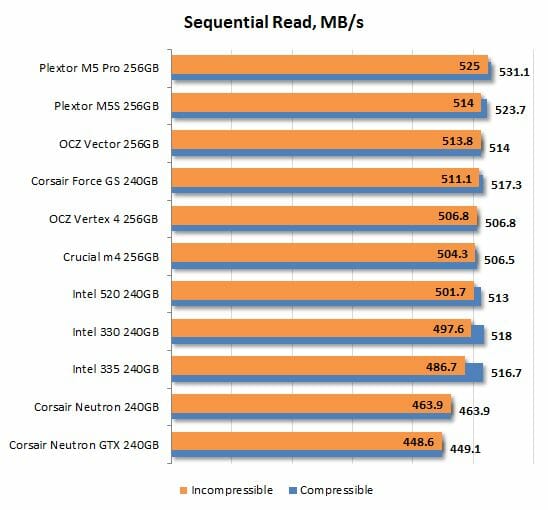
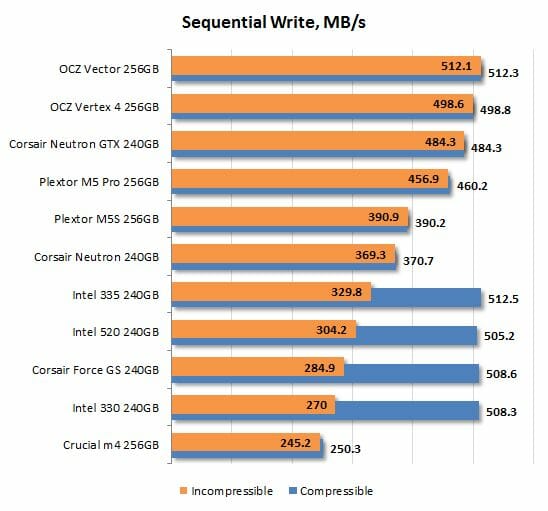
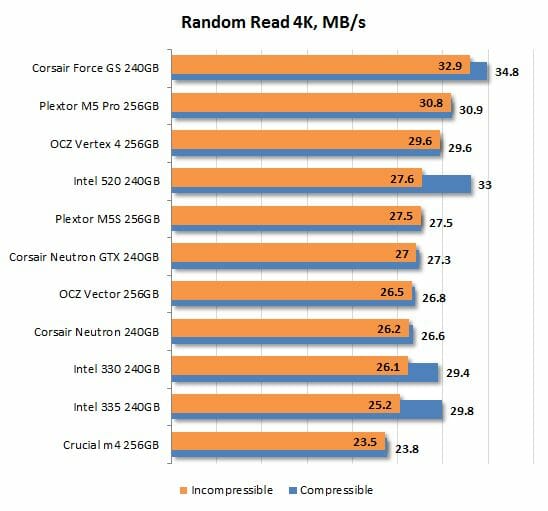
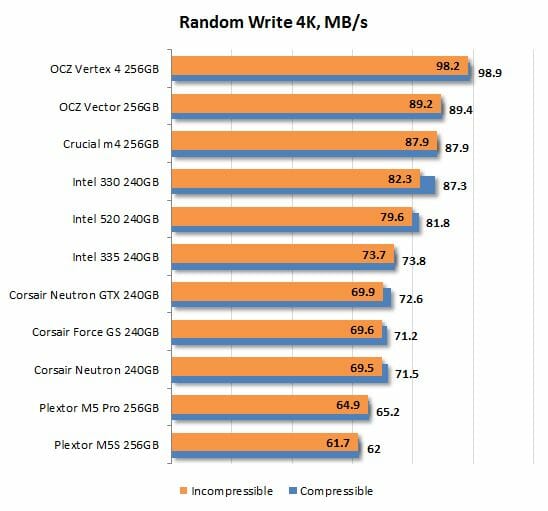
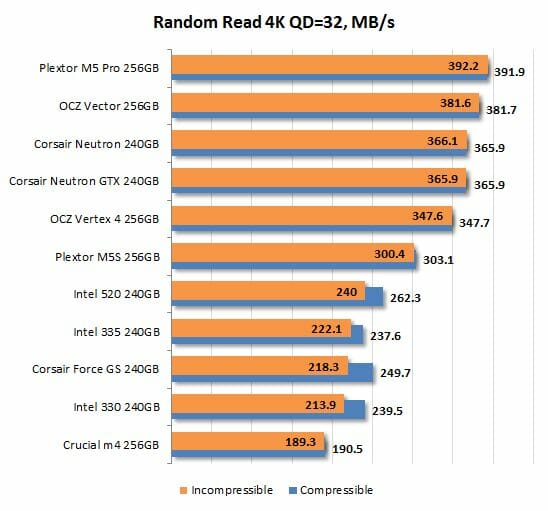
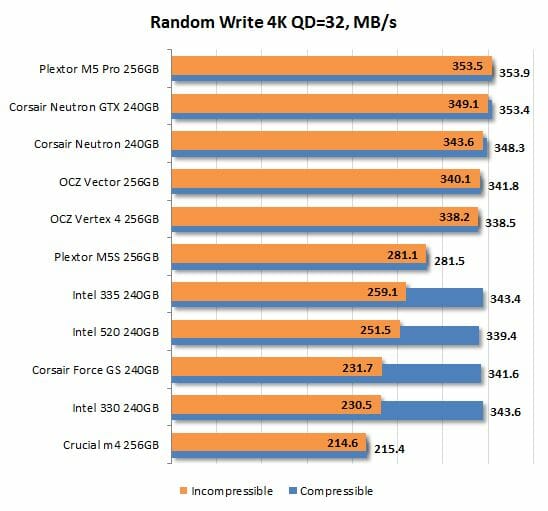
Whatever is written in the official specs of the new Intel SSD 335, we wouldn’t equate it to the SSD 330. It is different for some reason, which may be the 20nm flash (which theoretically has lower latency) or firmware or both. It delivers higher performance than the Intel SSD 330 when the request queue is long and also features higher sequential write speed than the other Intel SSDs. The 335 model is inferior to the SSD 330 in the other scenarios, though.
The SSD 335 isn’t exceptional. Its behavior is overall the same as that of any other SandForce-based SSD, so it is only average in performance by today’s standards. Flagship products are considerably faster and, unlike their SandForce-based opponents, deliver consistent performance with any types of data. Intel’s SSDs compress data prior to writing it into the flash memory and slow down when data is incompressible.
Degradation and Steady-State Performance
Unfortunately, SSDs are not always as fast as in their “fresh” state. In most cases their performance goes down after some time and in real life we deal with completely different write speeds than what we see on the diagrams in the previous chapter of our review. The reason for this phenomenon is the following: as the SSD runs out of free pages in the flash memory, its controller has to clear memory page blocks before saving data into them, which causes substantial delays. Although, modern SSD controllers can alleviate the performance drop by erasing unused flash memory pages ahead of time, when idle. They use two techniques for that: idle-time garbage collection and TRIM.
Of course, users are more interested in the consistent performance of their SSDs over a long period of time rather than the peak speed they are going to see only during the initial short-term usage period, while the drive is still “fresh”. The SSD makers, however, declare the speed characteristics of “fresh” SSDs for marketing reasons. That’s why we decided to test the performance hit that occurs when a “fresh” SSD becomes a “steady” one.
To get a complete picture of SSD performance degradation we ran special tests based on the SNIA SSSI TWG PTS (Solid State Storage Performance Test Specification) methodology. The main idea of this approach is to measure write speed consecutively in four different cases. First we measure the “fresh” SSD speed. Then we measure the speed after the SSD has been fully filled with data twice. The third test occurs after a 30-minute break during which the controller can partially restore performance by running the idle-time garbage collection. And finally, we measure the speed after issuing a TRIM command.
We ran the tests in synthetic IOMeter 1.1.0 RC1 benchmark, where we measured random write speed when working with 4 KB data blocks aligned to flash memory pages at 32 requests queue depth. The test data were pseudo-random. The following diagram shows the history of the relative speed changes, where 100% refers to the SSD performance in “fresh-out-of-box” state.
SandForce-based SSDs suffer a performance hit when they run out of free memory pages. They slow down with use due to poor garbage collection algorithms. This is actually the controller’s problem because it can be observed with any firmware. The performance hit has become less severe with faster flash memory as is indicated by the Intel SSD 335 as well as the Corsair Force GS (which is equipped with 24nm Toggle Mode NAND flash). The Intel SSD 330 would slow down by 15% when writing with a long request queue whereas the Intel SSD 335 only slows down by 10% when writing 4KB data blocks with a long request queue.
Anyway, we wouldn’t recommend using SandForce-based SSDs, including Intel ones, in operating systems without TRIM support. Otherwise, you may find yourself disappointed with the eventual and noticeable deterioration in the performance of your SSD.
Since the characteristics of most SSDs do change once they transition from fresh out-of-the-box state into steady state, we measure their performance once again using CrystalDiskMark 3.0.1 benchmark. The diagrams below show the obtained results. We use random data writing and measure only performance during writes, because read speed remains constant.
Intel’s SSDs are closer to each other in terms of steady-state performance, but the SSD 520 proves its higher positioning by being slightly faster than the SSD 335 and SSD 330.The two affordable drives are similar in this test and do not impress much compared to their opponents. Well, second-generation SandForce controllers have been around for over 2 years already, so it’s no wonder that they fail to compete with newer solutions. Intel’s exclusive firmware cannot save the day, so the only good news for the SF-2281 controller is that it is good in typical desktop usage scenarios that involve a lot of reading.
Futuremark PCMark 7
The popular PCMark 7 contains an individual disk subsystem benchmark. It is not a synthetic test, but is based on real-life applications. This benchmark reproduces typical disk usage scenarios and measures how fast they are completed in popular applications. Moreover, the disk access commands are not executed as a steady uninterrupted flow, but in a more realistic manner – with certain pauses caused by the need to process the data. The benchmark generates an overall disk subsystem performance rating as well as speed readings in MB/s in individual usage scenarios. Note that the absolute speed in these scenarios is not too high because of the above mentioned pauses between individual input/output operations. In other words, PCMark 7 shows you the speed of the disk subsystem from the application’s point of view. Numbers like that show us not only the pure performance of an SSD, but mostly how big of a performance gain a certain SSD can guarantee in real life.
We ran PCMark 7 on “steady” SSDs, which is what they are going to be in actual computer systems most of the time. Their performance in this case is affected not only by their controller or flash memory speed but also by the efficiency of their internal algorithms that fight performance degradation.
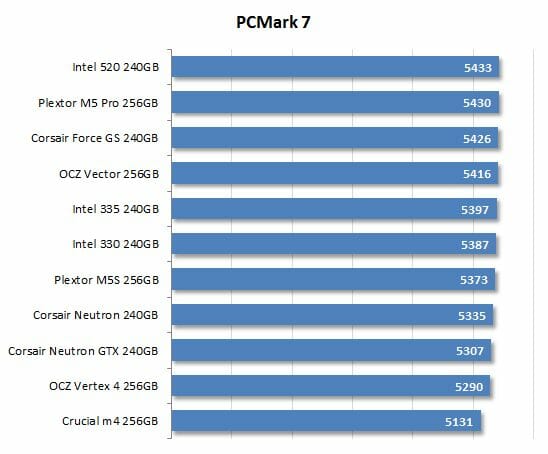
Using compressible files, PCMark 7 is often very positive about SandForce-based SSDs. The Intel SSD 520 even wins this test, beating the opponents that use newer controllers. Intel’s affordable SSDs cannot rise above the average level, though. They are also close to each other, suggesting that PCMark 7 cannot find any difference between 20nm and 25nm flash memory.
Now let’s check out the individual tests to get a more detailed picture of what our SSDs are capable of under various types of operational load:
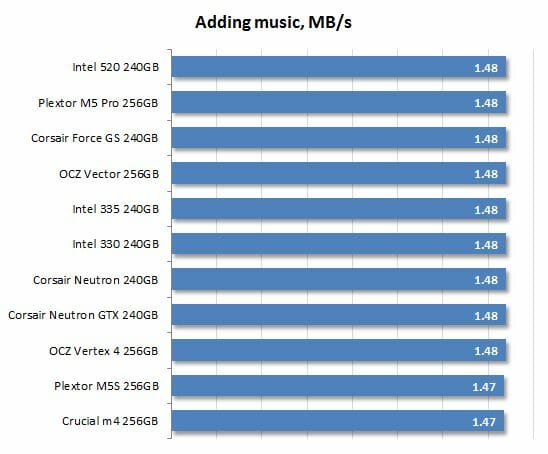
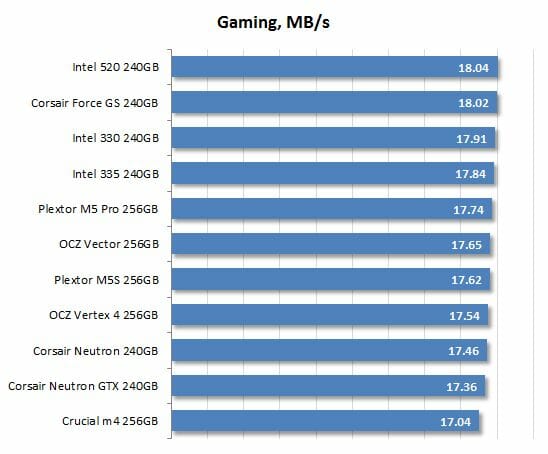
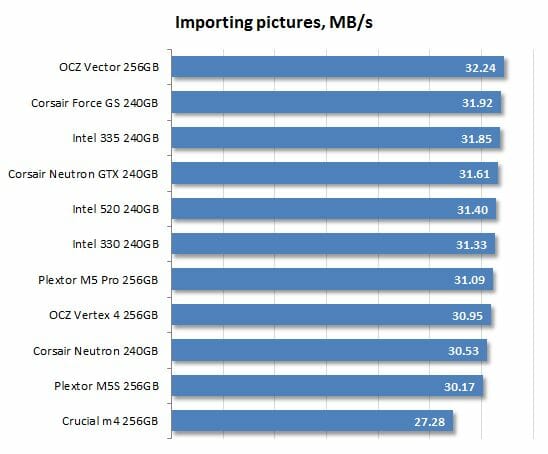
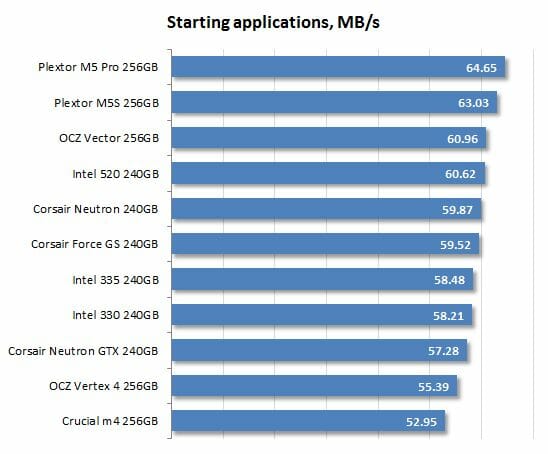
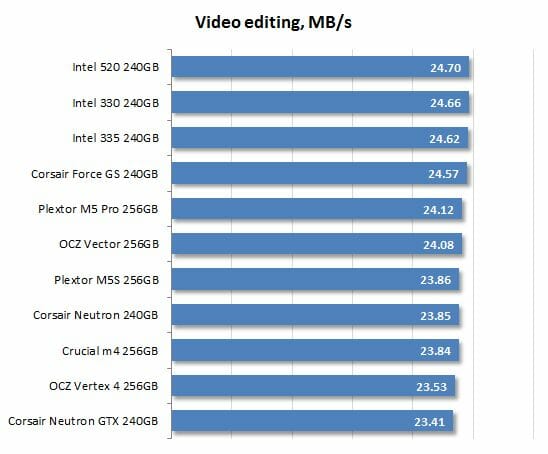
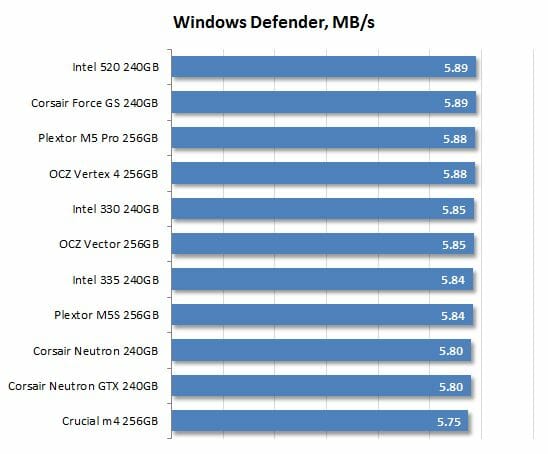
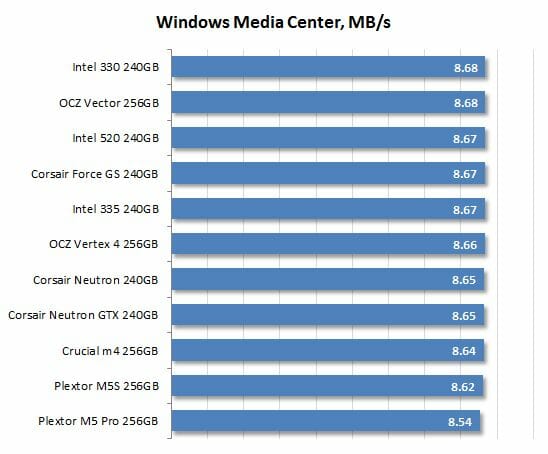
It must be noted that the good showings of the Intel SSDs in terms of overall PCMark 7 scores are due to their high speed in the Gaming and Video Editing traces. Meanwhile, they are far from brilliant in the most important Starting Application trace, which indicates that SSDs like Intel’s 330 and 335 are not really versatile. That said, the new SSD 335 has good market perspectives thanks to its pricing. It is superior to many other offers in terms of its price/performance ratio.
Intel NAS Performance Toolkit
Intel NASPT is another disk sub-system test that uses real-life usage scenarios. Like PCMark 7, Intel NASPT reproduces predefined disk activity traces and measures how fast they are executed. However, the default traces are designed for network attached storage devices rather than for SSDs. Therefore during our test session we replace them with the specially developed SSD Benchmarking Suite which offers more relevant usage scenarios such as compressing and decompressing files, compiling large projects, copying files and folders, loading 3D game levels, installing software, batch-processing photos, searching a digital library for data, mass-launching applications, and transcoding video.
Like PCMark 7, this benchmark gives us a true-to-life illustration of disk subsystem performance. Here the SSDs are again tested in their “steady” state.
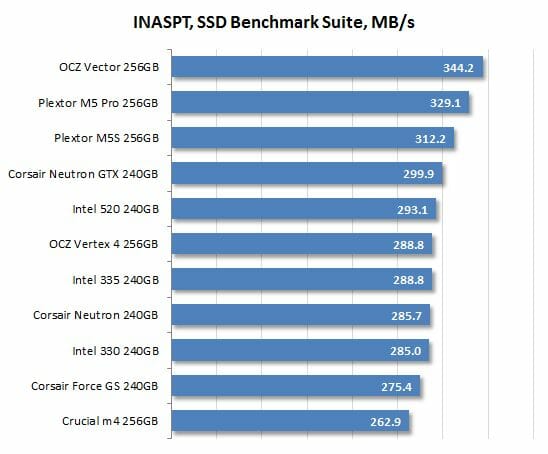
Intel NASPT provides a more adequate picture of real-life SSD performance, in our opinion, and the Intel SSD 335 is almost as fast as the Intel SSD 520 here. It also means that the new affordable drive from Intel is ahead of the older one. Although unable to compete with the leaders like the OCZ Vector, Plextor P5 Pro and P5S, the Intel SSD 335 beats such popular solutions as Corsair’s Neutron and Crucial’s m4. This benchmark proves the benefits of Intel’s exclusive firmware, by the way. Any of the Intel SSDs is faster than the Corsair Force GS which is based on the same SandForce SF-2281 controller.
Besides the average benchmark score, we would also like to offer you the results of individual usage scenarios, which will show where Intel SSD 335 can really shine. Note that the data-transfer rate is higher than the SATA III interface bandwidth in some subtests. That’s because INASPT is a high-level test that uses standard Windows functions to access the disk subsystem. As a result, the OS caching mechanisms also affect the results.
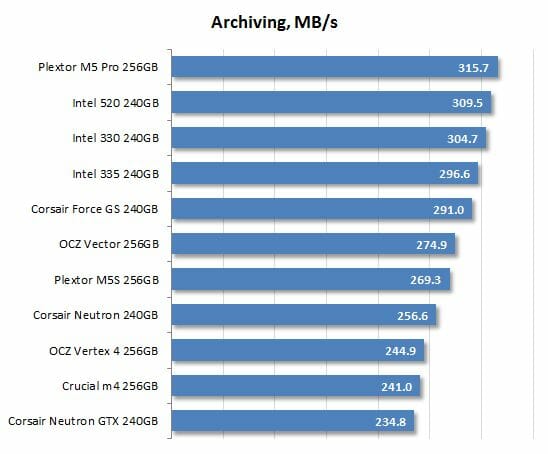
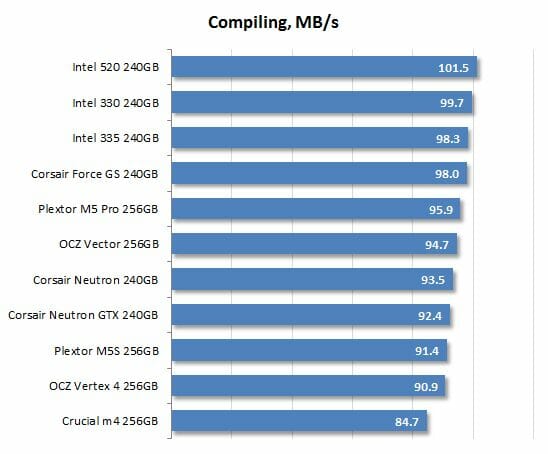
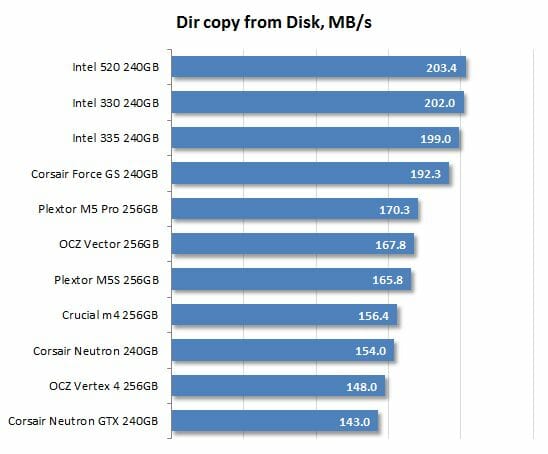
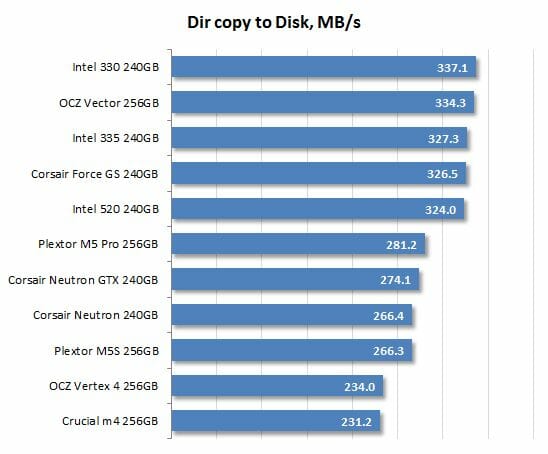
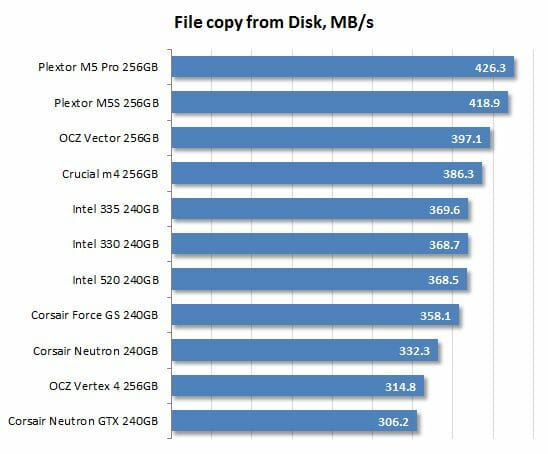
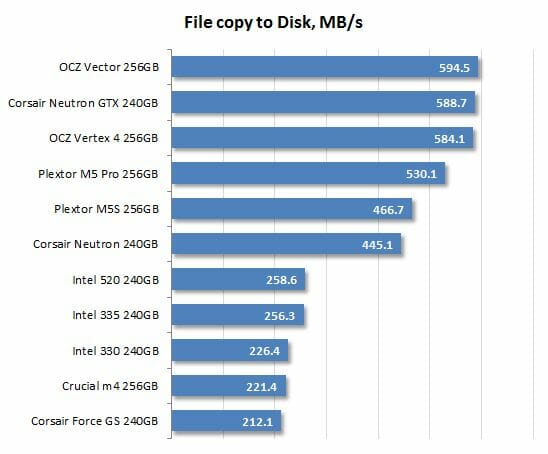
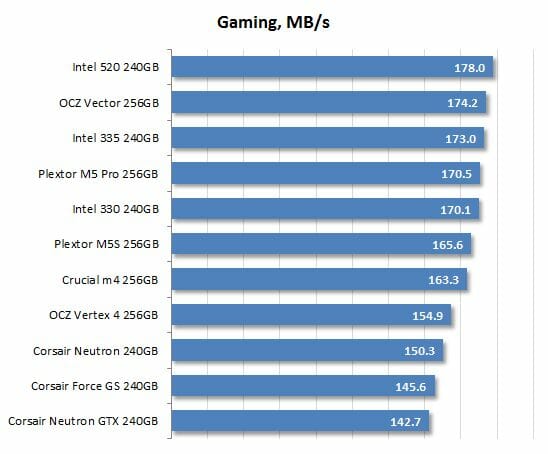
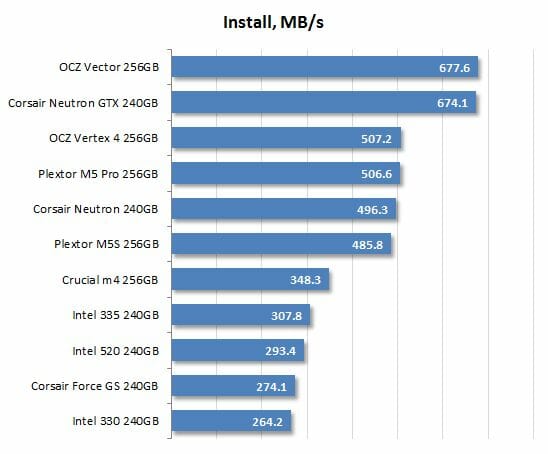
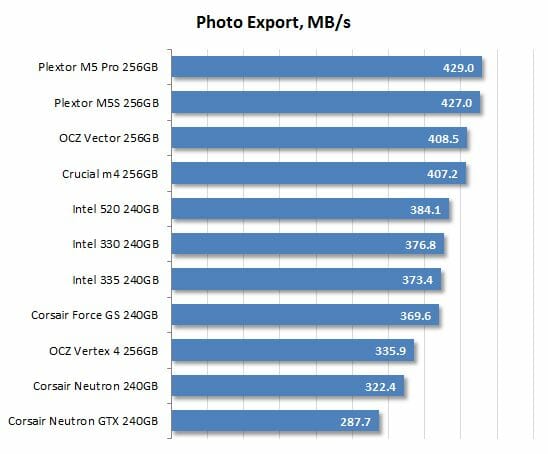
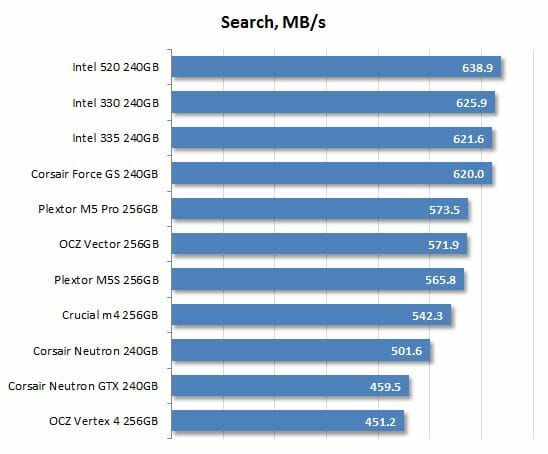
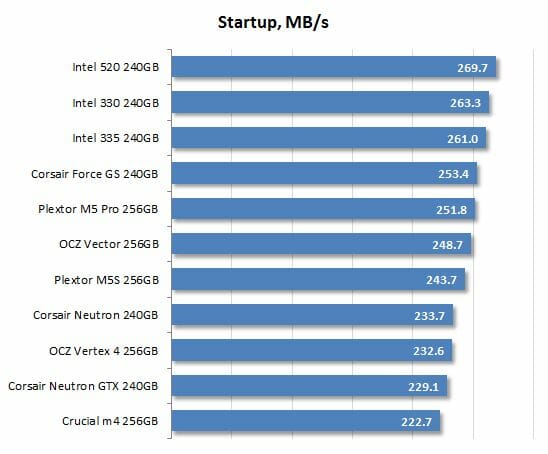
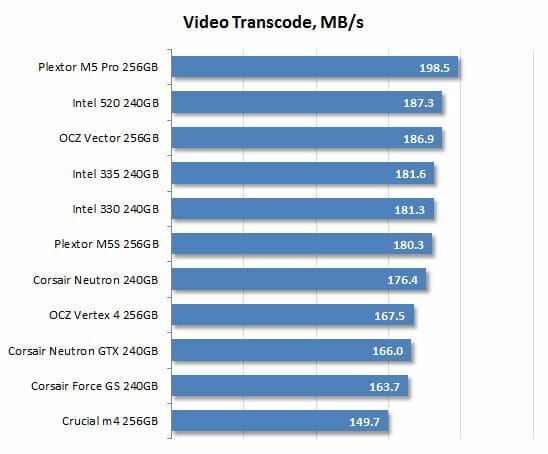
Intel’s firmware is optimized for real-life scenarios, so when we switch from synthetic benchmarks to those that simulate the actual use of the disk subsystem Intel SSDs often turn out to be superior to their opponents. Of course, no firmware optimizations can make up for the low writing speed of the SandForce controller, but the Intel SSD 335 is very good when there is a lot of reading to be done. Such scenarios are present in NASPT as well as in reality: software compilation, copying folders from the SSD, launching programs, searching for data, gaming, etc. Summing up, we can say that Intel’s SSD 520 and SSD 330 cannot set any performance records in benchmarks but can hardly disappoint you in real-life usage scenarios.
File Copy Speed
We use AS SSD version 1.7.4739.38088 test to benchmark the speed of copying files within a single partition the size of the whole SSD. The SSDs are tested in their steady state.
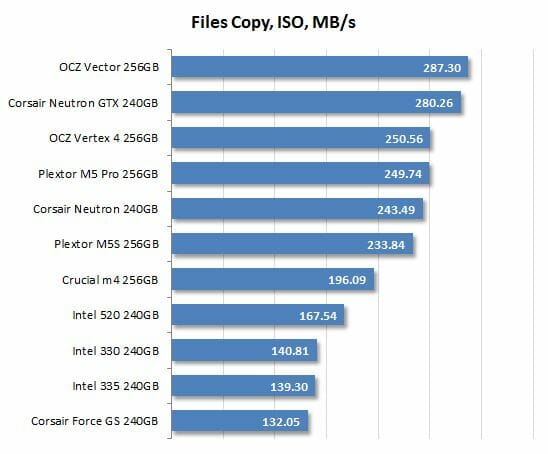
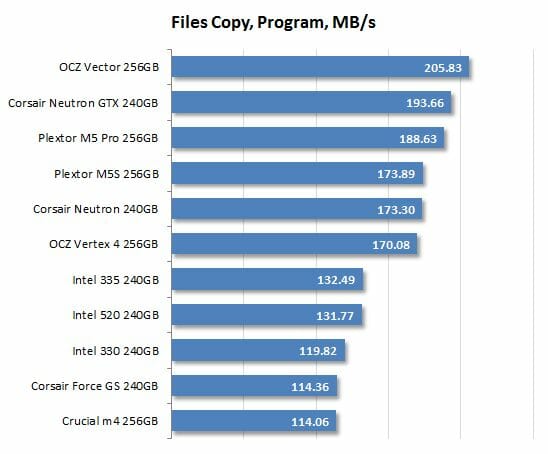
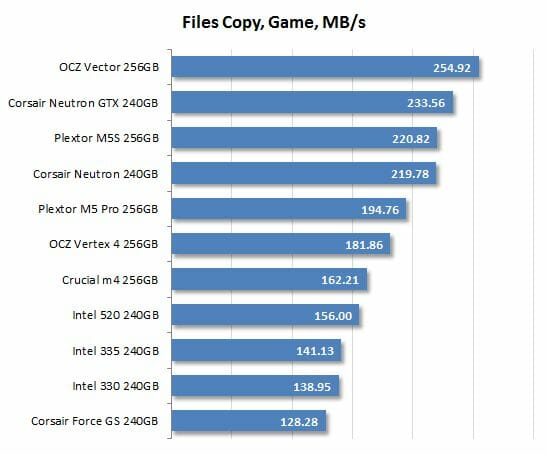
The Intel SSD 335, like the other SSDs from Intel, is too slow in this test because copying involves both reading and writing files. While SandForce-based SSDs are good at reading, writing slows down the whole process, dragging such SSDs down to the bottom of the diagrams.
Conclusion
Although Intel markets its affordable SSD 335 as a slight refresh to the old SSD 330 series, the new product is actually quite exciting. The synchronous MLC flash manufactured on 20nm tech process at IMFT facilities improves three key parameters: performance, power consumption and price. As a result, the SSD 335 is faster than its predecessor, taking its place between the SSD 330 and the SSD 520. Its power requirements are lower by half. And as for the price factor, it is perhaps the least expensive SSD based on synchronous MLC NAND flash available today!
Considering that Intel SSDs have always been highly reliable and their firmware is optimized for real-life usage scenarios, we have a potential bestseller here. Of course, it is no leader in sheer speed, yet still an excellent choice for all-purpose PCs. The only problem is that the SSD 335 is available as a 240GB version now. If it comes out in other capacities as well, it may affect the overall market situation, provoking a general reduction in prices of consumer-class SSDs.
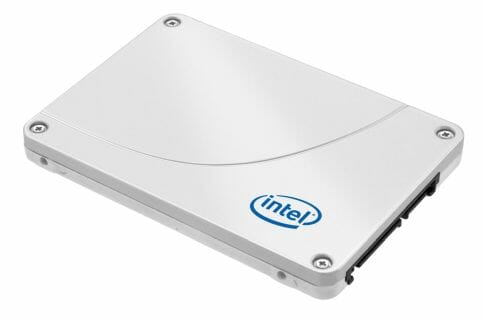
The Intel SSD 335 isn’t without downsides, which are related to its second-generation SandForce controller. Namely, it has rather low write speed and suffers a performance hit with incompressible data. These aspects may be crucial for some users, who will most likely prefer a different product because of that. And there are quite a few alternative choices, actually: Plextor M5 Pro, OCZ Vector, Samsung 840, etc. To help you with your choice, we offer the following summary table with test results of various SSDs. It contains basic hardware information about the tested SSDs and allows to quickly determine the general position of a particular model among its competitors in terms of relative performance.